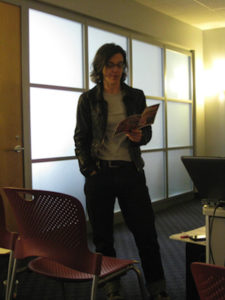 On October 11, 1988, AIDS Coalition to Unleash Power (ACT UP) organized a demonstration to put pressure on the Food and Drug Administration (FDA) to more quickly develop and make available drugs for people with AIDS. Thousands of protestors shouting, “Hey, hey, FDA, how many people have you killed today?” blocked doors, walkways, and a road leading to the agency’s headquarters in Rockville, Maryland, effectively shutting it down for a day. In the aftermath of this action, members of ACT UP were included in discussions with the FDA about antiviral AIDS drug development, ultimately transforming the clinical trial process in ways that helped people get the drugs they needed sooner.
On October 11, 1988, AIDS Coalition to Unleash Power (ACT UP) organized a demonstration to put pressure on the Food and Drug Administration (FDA) to more quickly develop and make available drugs for people with AIDS. Thousands of protestors shouting, “Hey, hey, FDA, how many people have you killed today?” blocked doors, walkways, and a road leading to the agency’s headquarters in Rockville, Maryland, effectively shutting it down for a day. In the aftermath of this action, members of ACT UP were included in discussions with the FDA about antiviral AIDS drug development, ultimately transforming the clinical trial process in ways that helped people get the drugs they needed sooner.
In the face of the Trump administration’s apparent lack of concern for Americans’ access to healthcare, and active attempts to strip funding from women’s health resources, one might feel a desire to return to these early days of AIDS activism. But in her recently published book Indirect Action: Schizophrenia, Epilepsy, AIDS, and the Course of Health Activism Lisa Diedrich, Associate Professor of Women’s, Gender, and Sexuality Studies at Stony Brook University, wonders whether we should take this as our model for contemporary health activism. Although she acknowledges the importance of ACT UP’s work, she asks what forms of activism are obscured in the past and foreclosed for the present when we take as exemplary this use of direct action tactics to shape pharmaceutical research and get drugs into bodies. By looking at earlier forms of health activism, from the women’s health movement to antipsychiatry to environmental justice, she uncovers an alternative model that she calls indirect action.
We spoke by phone about remembering health activism of the past and doing health activism in the present.
Jesse Miller: Academic books are all about subtitles. I think you mentioned in a previous conversation that you had intended the subtitle of Indirect Action to be “Illness-Thought-Activism” but that the press persuaded you to change it to “Schizophrenia, Epilepsy, AIDS, and the Course of Health Activism.” I’m curious, why do you think the press preferred this, and what do you think was lost in the editorial change?
Lisa Diedrich: Well that’s right, you’ve got it right, the subtitle I had was “Illness-Thought-Activism.” I liked this more general framework because that’s what I’m interested in exploring, this conjunction of illness, thought, and activism, rather than the specificity of a particular illness. Although it’s not that I don’t care about that, but it’s more secondary. The press wanted it to be, to use a term I’ve heard, “discoverable”: that if someone was looking for something about schizophrenia this would come up, or about epilepsy or AIDS, and I just decided, well I’ll go along with their knowledge about how people find books. Although it does slightly concern me that someone might be looking for a book about something like epilepsy and might be annoyed about what they discover in this book in terms of it not being directly about epilepsy. So there’s this discussion about who you want to read your book and how you get your work out there and into the hands of people who might be interested in it. I sort of defer to the publisher on that. I’m curious about how that will go in terms of who finds the book and how they feel about it.
And I guess marketing tends to be more direct than indirect.
Yes exactly. Yes that’s a good point. Which is why I let them do it. I’ve often been told I have a suggestive writing style and style of argument. So I’m pretty willing to take peoples’ suggestions for ways to be more direct. But obviously indirection is thematic for this project.
That’s something I wanted to get to with you. It seems like even though its not exactly a historical account, at the heart of the book is this argument that looking at health activism before 1987 and ACT UP can provide resources for health activism in the present. And it can do so by revealing an indirect alternative to direct action politics. So what exactly is this historical narrative that you’re setting out to challenge?
The first thing I want to challenge — and I’m not the only person to have challenged this — is this origin story that says that health activism begins with AIDS and ACT UP in 1987. And that’s a story with this arc that says: we had this initial moment of passivity in relation to the disease and then partly thanks to Larry Kramer we have this decision to be more radical, more militant in 1987 because we failed to really get the government to respond, etc. So this arc from passivity to activism.
Even in the early 80s people like Cindy Patton, who was my dissertation advisor, were challenging this. She was already saying it’s not that people aren’t responding politically to this disease, they are, it’s just a certain kind of politics. I mean any kind of response to illness and trying to get resources to respond to illness is politics. And so I want to also again challenge that story which was: we finally have health activism, thank goodness, and this direct action politics that came with ACT UP really changed the course of the history of AIDS. And I want to challenge that without diminishing ACT UP’s importance and their role in responding to the AIDS crisis because I think ACT UP was incredibly important. And it was the activism around AIDS that motivated the need to do this kind of project. So it’s not a rejection of AIDS activism at all. But it’s looking at what this activism emerged out of.
I’m also interested in the way we tell these histories about illness, thought, and politics in the present. There is some concern about who becomes the figure of the AIDS activist — it becomes the white gay male. But there were many people who don’t fit that description who were active in that moment. There are also these figures that I refer to as relay figures who were connecting AIDS activism to earlier activism. Feminist activism for sure but also other things like antipsychiatry and environmental justice work. So I want to show those links. I’m interested in what creates links between movements and by thinking about the connection and disconnections between movements. I think that’s useful for how we do politics in the present. So that’s the resource. Doing that kind of historical work means that we see that this doesn’t emerge out of nowhere. There was someone like Sarah Schulman or Gregg Bordowitz, Félix Guattari: people who were making these connections between earlier movements, different places and spaces. This is an important role. I want to remind people that part of politics is serving as a relay. It’s not about you, it’s that you can serve as a relay between people, places, movements.
Since Trump was elected healthcare issues have been very visibly part of the political agenda. I’m thinking about things like the threats to funding and access to Planned Parenthood and attempts to repeal and replace the Affordable Care Act. And there have also been a range of responses to what you might call this “emergency time.” Things like calling senators, the women’s marches, the direct actions of disability activists associated with groups such as ADAPT. So thinking about your work as a history of the present, I’m wondering: in your research into the history of health activism what did you discover that you think is useful for understanding or responding to this moment?
I definitely want people to read my book in relation to what’s going on right now because I’m not sure if everybody understands that illness and how we do illness is political. And the idea that the personal is political relates very much to illness politics. I think of illness politics as similar to and connected to and intersecting with sexual politics and racial politics and class politics. Disability activists are some of the people doing this work the best right now. Because they really understand that disability is central to almost everything that we do as a society. So essential to questions about healthcare but also central to questions about policing and prisons and war and education. It’s connected to almost anything. If you look at an issue through a disability lens it gives you a really important perspective.
I just actually wrote something for a more general audience about illness politics and looking specifically at ADAPT and their work, and one of the things that I note is that I’ve seen some stuff on twitter that compares the direct actions of ADAPT to ACT UP. And so there’s a sense that ADAPT has been influenced by ACT UP. But of course ADAPT preceded ACT UP by at least 10 years. So this is precisely the kind of thing that I’m interested in, that we forget this longer history of ADAPT and of disability politics connecting back to an important movement that emerged in the late 60s and early 70s, the independent living movement. This basically was a movement for self-determination of disabled people. Gregg Bordowitz talks about how ACT UP was very interested in and influenced by these movements of self-determination. So there’s this link that would see direct connections between ADAPT and ACT UP. But with ADAPT actually being the precursor. And the fact that that’s not how we tell this story is again interesting because there’s a forgetting of the longer history of this kind of activism.
So we have this sense of illness being used politically and also the more personal or intimate aspects of illness, thought, and politics. I noticed that in relationship to the treatment activism that you discuss — activism aimed primarily at getting drugs into bodies — you focus alternatively on things like love and care. And I think for some people this idea that you could advocate for those things in response to the concrete experience of illness would sound sentimental. Are they wrong?
There’s the danger of sentimentality, for sure, anytime you begin to talk about love and care. And actually the other word I’ve been thinking a lot about is “therapeutic,” and in particular in relation to social spaces. I’m really interested in how we might produce therapeutic social spaces. And of course that can be derided. I can hear the criticism of that in the sense of “safe spaces” and the criticism of “snowflakes” and that kind of thing. I’ll take that, that’s fine. Because I actually think we’re not doing a very good job of producing therapeutic social spaces. So I‘m very interested in people who are actually doing that kind of work.
I also think it’s important to think about politics this way, that if you do politics simply for the immediate result — like you do something because you want this end to happen — you’re going to likely be discouraged by politics. The main reason to do politics is for the experience of doing political work with others and trying to bring about change with others. And you can see this with the ADAPT activists in Denver for example who recently took over a senator’s office. You can see their joy that they’re doing this activism. We need to think about politics as about creating a space for love, care, joy, rather than just the negative emotions that we often associate with politics. I’m not saying that people are not motivated by anger, it’s hard not to feel angry right now. But why do we do what we do, and what are we trying to create in doing what we do? The therapeutic is a good thing to work towards. It’s been derided, but it shouldn’t be. We want spaces where people feel good and feel cared for and are cared for.
This is sort of a question about academic writing but I think it can also apply to cultural criticism more generally and that’s this question about whether there’s a relationship between experimental form and experimental thinking. Your book has an unusual form, with these longer narrative chapters alternating with short “snapshots” that are not chronological but function as a kind of relay. In them you focus on a piece of art or literature and describe how it freezes and diagrams a moment or a thought or an idea about illness and politics. Does formal academic or analytic critical writing prevent us from certain kinds of thoughts that more experimental forms of writing make possible?
I think so. I’m drawn to generalism and people who are able to move between topics, issues, forms, genres, disciplines. I think that this capacity to go between is really important in terms of analysis. So yes this is why I’m interested in challenging a more straightforward form or trying to enact something through the form of the book. I still use analysis and critical theory. I mean I actually think I’m doing critical theory and analysis. But I do want to challenge an idea of what we think that is, and that’s partly by considering what we think that looks like.
John Berger, in his book Ways of Seeing from 1972, which was actually a BBC series first, talks about the diversity of ways of seeing and also how representation structures our way of seeing and that every representation contains a way of seeing. This was very much on my mind as I was working on this. We can’t take for granted that we know what illness looks like or that we know what illness is. And so it’s important to think about the norm in which we present illness. And that also goes for thought and politics. I don’t want my book to be something that people would say — oh I have to copy this method and I have to do a book that looks like this. But I do hope that people are motivated to think about how they do the book because they’ve read mine.
Jesse Miller is a reviews editor at Full Stop and lives in Buffalo, NY.
This post may contain affiliate links.







